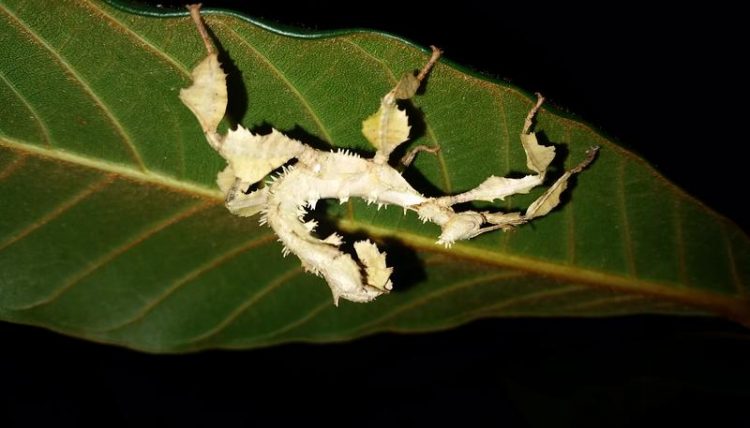How stick insects handle indigestive food

A young Australian stick insect (Extatosoma tiaratum) hangs upside-down on a houseplant at the Max Planck Institute for Chemical Ecology. Matan Shelomi / Max Planck Institute for Chemical Ecology
Cellulose as well as xylan and xyloglucan are important components of plant cell walls. All walking sticks ((Phasmatodea) inherited multiple copies of cellulase genes, whose enzymes can attack the glucose backbone of cellulose.
However, some of these enzymes can also break down the xylose-backbone of xylan, and others the xylose-glucose backbone of xyloglucan. This discovery marks the first known xyloglucanase of any kind to be found in multicellular animals. Such enzymes in animals were previously not thought to exist.
One enzyme, many substrates
Researchers in the Department of Entomology isolated the cellulase genes from seven species of stick insect, including the Australian Extatosoma tiaratum, the Vietnamese Ramulus artemis, and the Bornean Aretaon asperrimus.
All express multiple different cellulase enzymes from the glycoside hydrolase family 9 (GH9). Maintaining redundant enzymes does not make sense if all have the same function, so the researchers hypothesized some had lost their function or evolved to do something new.
To test what these enzymes were capable of, the genes were expressed in a stable insect cell line, and the activities of the isolated proteins tested against different plant cell wall polymers. The results showed that one groups of enzymes were active against cellulose and xylan, and another cellulose and xyloglucan, and several in each group could also degrade glucomannan.
These abilities held in all families of stick insects, present in the Vietnamese Medauroidea extradentata (Family Phasmatidae), the Madagascan Sipyloidea sipylus (Diapheromeridae), and the Peruvian Peruphasma schultei (Peruphasmatidae). The researchers even got samples of the Californian Timema cristinae (Timematidae), considered the sister group to all other Phasmatodea, and found the same enzymes with the same new abilities.
Such multifunctionality is almost unheard of from glycoside hydrolases 9, and xyloglucanases of any family were never discovered in animals before. “If we hadn’t tested these enzymes on other substrates besides cellulose, there was no way we could have discovered these functions,” said Dr. Matan Shelomi, a postdoctoral fellow at the Max Planck Institute for Chemical Ecology and lead author of the study. “It was good that we did: nobody found these kind of powerful enzymes in an animal before.”
A new twist on an old gene family
Most importantly, the enzyme functions matched the evolutionary relationships between the insects. Xylanase-cellulases from different species were closely related, and the xyloglucanase-cellulases also formed a monophyletic group. Because T. cristinae also had these activities, this means an ancestral, insect cellulase gene duplicated into several genes, some of which were then able to evolve new abilities. This happened before the Phasmatodea evolved. Next the researchers are testing other insects related to the stick insects, to see if they have multifunctional cellulases too.
The ability to break down different polymers with the same enzymes means the Phasmatodea gut is unusually efficient. Along with other enzymes such as cellobiases and xylobiases, their guts can fully degrade nearly all the plant cell wall into its component sugars, using them for nutrition as well as having more access to the easily digested cytoplasm within the cells.
This means they can derive more nutrition from the same leafy diet than other herbivores. Theoretically, they could even digest wood. “There is a big community in Germany of people with stick insects as pets,” says Shelomi, “and they report them nibbling on sticks, moss, bark, and even Styrofoam and electric cables… but leaves are still their main food. Maybe their gut can break down wood, but their jaws are better suited for leaves, which probably taste better too.” [MS]
Original Publication:
Shelomi, M., Heckel, D. G., and Pauchet, Y. (2016). Ancestral Gene Duplication Enabled the Evolution of Multifunctional Cellulases in Stick Insects (Phasmatodea). Insect Biochemistry and Molecular Biology 71: 1-11. Doi: 10.1016/j.ibmb.2016.02.003
http://dx.doi.org/10.1016/j.ibmb.2016.02.003
Further Information:
Dr. Matan Shelomi, Max Planck Institute for Chemical Ecology, Hans-Knöll-Str. 8, 07743 Jena, Germany, Tel. +49 3641 57-1560, E-Mail mshelomi@ice.mpg.de
Contact and Media Requests:
Angela Overmeyer M.A., Max Planck Institute for Chemical Ecology, Hans-Knöll-Str. 8, 07743 Jena, +49 3641 57-2110, E-Mail overmeyer@ice.mpg.de
Download high-resolution images via http://www.ice.mpg.de/ext/downloads2015.htm
http://www.ice.mpg.de/ext/1260.html?&L=0 (How stick insects handle indigestive food)
http://www.ice.mpg.de/ext/655.html (Project Group “Molecular Biology of the Insect Digestive System”)
http://www.ice.mpg.de/ext/entomology.html?&L=0 (Department of Entomology)
Media Contact
All latest news from the category: Life Sciences and Chemistry
Articles and reports from the Life Sciences and chemistry area deal with applied and basic research into modern biology, chemistry and human medicine.
Valuable information can be found on a range of life sciences fields including bacteriology, biochemistry, bionics, bioinformatics, biophysics, biotechnology, genetics, geobotany, human biology, marine biology, microbiology, molecular biology, cellular biology, zoology, bioinorganic chemistry, microchemistry and environmental chemistry.
Newest articles

A ‘language’ for ML models to predict nanopore properties
A large number of 2D materials like graphene can have nanopores – small holes formed by missing atoms through which foreign substances can pass. The properties of these nanopores dictate many…

Clinically validated, wearable ultrasound patch
… for continuous blood pressure monitoring. A team of researchers at the University of California San Diego has developed a new and improved wearable ultrasound patch for continuous and noninvasive…

A new puzzle piece for string theory research
Dr. Ksenia Fedosova from the Cluster of Excellence Mathematics Münster, along with an international research team, has proven a conjecture in string theory that physicists had proposed regarding certain equations….



